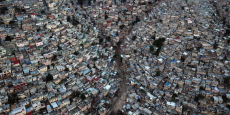

Haiti Earthquake
Recap: Before the earthquake
Haiti was 145th of 169 countries in the UN Human Development Index, which is the lowest in the Western Hemisphere
More than 70% of people in Haiti were living on less than $US2 per day
86% of people in Port au Prince were living in slum conditions - mostly tightly-packed, poorly-built, concrete buildings.
80% of education in Haiti was provided in often poor-quality private schools, the state system generally provided better education but provided far too few places
Half of people in Port-au-Prince had no access to latrines and only one-third has access to tap water
2 Weeks
21 January one pier at the Port-au-Prince seaport was functional, offloading humanitarian aid, and a road had been repaired to make transport into the city easier. On 23 January the Haitian government officially called off the search for survivors, after 132 found, and most search and rescue teams began to prepare to leave the country. However, as late as 8 February 2010, survivors were still being discovered, as in the case of Evan Muncie, 28, found in the rubble of a grocery store. 1,000 bed hospital ship. UN has begun hiring 220,000 Haitians to work on clearing-up.
3 Weeks
The UN World Food Program started handing out food only to women with vouchers in Port-au-Prince on Sunday, to control the near-riotous conditions that had previously been encountered. The UN is employing over 12,000 Haitians in rubble clearance, as part of the relief effort, to provide jobs to the needy. The project is called the cash-for-work scheme and pays labourers $4 for a half-day's work, and also provides food. Cuba has announced it will dispatch a fifth field hospital to Haiti, for Les Cayes. South Korea is preparing to send 250 peacekeepers to Léogâne. Electricity was restored to some sectors of Pétionville and Carrefour at the beginning of February
Reconstruction/Recovery
First Year
from 20 January, people would be helped to relocate outside the zone of devastation, to areas where they may be able to rely on relatives or better fend for themselves; people who have been made homeless would be relocated to the makeshift camps created by residents within the city, where a more focused delivery of aid and sanitation could be achieved.
Six months after the quake as much as 98 percent of the rubble remained uncleared. An estimated 26 million cubic yards (20 million cubic meters) remained, making most of the capital impassable and thousands of bodies remained in the rubble. The number of people in relief camps of tents and tarps since the quake was 1.6 million, and almost no transitional housing had been built. Most of the camps had no electricity, running water, or sewage disposal, and the tents were beginning to fall apart. High Crime rate in camps.
In October 2010, Refugees International characterized the aid agencies as dysfunctional and inexperienced saying,"The people of Haiti are still living in a state of emergency, with a humanitarian response that appears paralyzed’’ In October, a cholera epidemic broke out, probably introduced by foreign aid workers. Cholera most often affects poor countries with limited access to clean water and proper sanitation. By the end of 2010, more than 3,333 had died at a rate of about 50 deaths a day, it still looks like the earthquake only happened yesterday.
image- https://www.france24.com/en/20181007-several-killed-haiti-earthquake-porte-paix

0 Comment:
Be the first one to comment on this article.